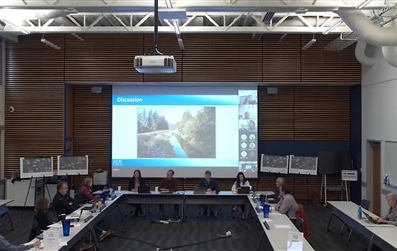Related News
Related News
-
McKenzie Valley electric service territory realignment study reaches key milestone
EWEB Commissioners approved a resolution authorizing the General Manager to negotiate and execute agreements with Lane Electric Cooperative regarding a potential realignment of electric service territory in the McKenzie Valley at the Board’s December meeting.
Find Out More -
EWEB Sets 2026 Budget and Rates, Advances Evaluation of McKenzie Valley Service Territory Realignment
Taken together, the 2026 budget and rate adjustments and the territory-realignment evaluation reflect EWEB’s dedication to responsible financial stewardship, modern, resilient utility infrastructure, and thoughtful planning for the future.
Find Out More -
EWEB secures $2.5 billion of reliable, affordable, carbon-free energy for customers
The new contract with EWEB’s largest energy supplier, the Bonneville Power Administration, forms the foundation of a diverse energy portfolio.
Find Out More -
Women in STEM: Meet the Hydro Project Engineer Building Habitat for Salmon
EWEB Engineer Associate Val Chang found her way to the McKenzie River from Los Angeles, inspired by heritage trips to the waters of Taiwan and key mentors along the way.
Find Out More -
Public Power Week Poster Contest Winners 2025
The results are in! View the winning posters from EWEB's 2025 Public Power Week Poster Contest.
Find Out More -
EWEB Hometown Heroes compete internationally
Out of 290 teams from 14 different countries, EWEB's Lineman Rodeo team places in the top third of competitors.
Find Out More -
Vote for your favorite Public Power Week Posters
The top five submittals will receive awards. Help us pick the winners.
Find Out More -
Electric Projects underway in North & South Eugene
Underground lines and disaster-resilient power poles are part of EWEB’s infrastructure upgrade near Eugene’s largest natural resource area.
Find Out More -
EWEB general manager to retire in 2026
EWEB launches nationwide search for next leader to continue the progress of the last decade and ensure a smooth transition.
Find Out More -
The Bonneville Power Administration Rate Change and Your EWEB Bill
BPA’s finalized rate increase is smaller than projected, and EWEB’s pass-through adjustment effective October 1, 2025 will now be 2.7% for residential customers—down from the anticipated 4%.
Find Out More -
EWEB completes helicopter installation of salmon habitat features
EWEB adds downed trees and 2,000 tons of gravel to the Uupper McKenzie River below Tamolitch Falls to improve spawning habitat.
Find Out More -
Oregon’s New Utility Laws and How EWEB Customers Already Benefit from Fair, Transparent Rates
Oregon’s POWER Act and FAIR Energy Act target investor-owned utilities. Learn how EWEB’s local, community-owned model already meets these goals.
Find Out More -
Court rules in favor of EWEB in Carmen-Smith litigation
The U.S. District Court in Eugene has granted EWEB's motion to dismiss a lawsuit brought under the Endangered Species Act pertaining to fish passage at EWEB’s Trail Bridge Dam. The favorable ruling clears the way for EWEB to continue advancing towards implementation of permanent fish passage at the dam.
Find Out More -
EWEB proposes modified plan for permanent fish passage at Trail Bridge Dam
After eight months of extensive collaboration and analysis with scientific experts at two federal regulatory agencies, EWEB is proposing an improved plan to build permanent fish passage facilities at Trail Bridge Dam on the McKenzie River.
Find Out More -
EWEB prepares for wildfire season with risk mitigation measures
EWEB is building a more resilient electric system to weather various types of disasters, from wildfire to winter storms.
Find Out More - Show More
The least negative decision—EWEB Board considers the future of Leaburg project
October 28, 2022

There’s no obvious right answer to the question of what to do about the Leaburg dam and canal. EWEB’s Board of Commissioners met this week for a work session with staff about the project. EWEB is required by federal regulators to address the structural deficiencies of the Leaburg canal. After initially studying 11 options, staff chose the four most feasible alternatives for comprehensive analysis. The options include full decommissioning, partial decommissioning, full return to service and partial return to service for the hydroelectric dam and canal.
All the choices are costly. Commissioner Sonya Carlson acknowledged that for some ratepayers, any increase in rates will be hard to swallow.
“We don’t have any good choices here. All of these have major cost implications. It’s going to be painful,” Carlson said.
Triple bottom line assessment of alternatives
EWEB staff prepared a triple bottom line assessment of the alternatives that looked at social, environmental and economic factors. For economic factors, we looked at the project cost (including its effect on rates), financing, and other economic issues. Environmental issues include climate, water and air quality, and fish and wildlife. Among the social issues staff analyzed were public safety, recreation, historic preservation, and tribal resources.
EWEB staff also gathered more than 400 public comments which will be presented to the Board next month. And commissioners weighed each alternative based on the triple bottom line values. EWEB Electrical Generation Manager Lisa Krentz told the Board each alternative came out with a net negative score.
“The decision comes down to choosing the least negative and recognizing that there are tradeoffs,” Krentz said. “Now please note that due to our mandate from the Federal Energy Regulatory Commission, doing nothing is not an option.”
The Board is not rushing this decision
EWEB General Manager Frank Lawson said he appreciates the weight of this decision.
“We want everybody, including the commissioners, to be comfortable and proud of this work. And it’s incredibly complicated and intertwined work,” Lawson said.
Lawson proposed that in December, staff would present a recommendation for a path forward which the Board can consider and share with interested parties including community groups for input. Commissioners decided to postpone their final decision.
“I always have this philosophy of better late than wrong,” said Commissioner John Brown.
Public power means customers have access to local board members who represent them
EWEB is a customer-owned public utility with local control. The EWEB Board of Commissioners is elected by EWEB customers and serves the public without pay. As board members consider the future of the Leaburg canal, they rely on EWEB staff for information, analysis, and recommendations. But ultimately, these public servants will make the choice.
Public comment has helped EWEB understand more about the potential impacts of each alternative.
The next board meeting is Nov. 1.
Transparency is a key part of this process
EWEB is committed to keeping the community informed about the progress and outcome of this decision. That means open access to information and creating opportunities for all members of the community to express their views, needs, concerns and priorities.
In addition to more than 400 public comments that we have received so far, we have hosted several public board meetings and presentations, and we have an extensive website available so that our customers have full and open access to all information.
If you would like to learn more about this project and register your comments, check out eweb.org/LeaburgCanal. From the website, you can also sign-up to receive project updates via email.

